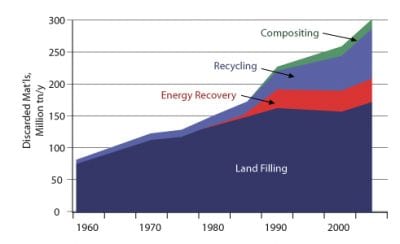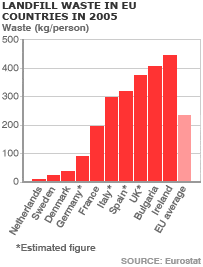The graph I looked at shows discarded materials by the millionth ton from the years 1960-2005. I found it very interesting and alarming that so much of our discarded materials are merely just thrown into landfills, along with the fact that only recently we as a society started converting our waste into energy and composting as well. 
As a nation, we are slowly becoming more sustainable, but we must continue working to fix our problems and find new ways to convert waste into clean energy. Another graph that I looked at is landfill waste in the European Union in 2005 (Netherlands, Sweden, Denmark, France, Italy, Germany, Spain, the UK, Bulgaria, and Ireland). The waste was measured in kilograms per person. 
I found this graph very interesting to see Ireland was leading the way in waste per person and the average for the EU was surprisingly high. Although the statistics are over ten years old, it’s surprising to see how high some countries landfill waste was. As humans, we should continuously work towards getting away from landfill usage and utilizing our waste for energy. At this pace, we will not be able to properly discard any of our materials, because landfills will be overwhelmingly large and our ozone will continue to deteriorate.


The graph of the landfill waste accumulation in Europe is interesting to me because often Europe is seen as a model for sustainable best practices, not as an example of accumulation of waste. I wonder how different the graphs for both Europe and the U.S. would look if the data was for 2018. I think that the average for the EU would be lower and the recycling and composting numbers would be higher in the U.S.
I definitely agree with you regarding the deterioration of the ozone layer. I was actually looking at NASA’s broad pictures of the ozone layers depletion beginning in September in 1979 to this month and the contrast is pretty scary. I don’t think people quite understand that there is not enough space on this earth for endless landfills. Either that or they don’t care but SHOULD given the statistics that you reiterate.
I agree that we as a nation need to continue to work to a more sustainable environment. Like you said, there needs to be an alternative way to dispose of waste, and people need to be aware of it. It is unforunate that we don’t take the time to really understand where our waste is going. That’s why we need to compost and recycle, just like we do on campus. Like your graphs have shown, making small changes will have a positive impact for years to come.
I agree with the point you raise about reducing our landfill use. Our everyday lifestyle products that we throw away can take centuries to degrade, which means that unless we do a better job disposing our trash, these landfills will inevitably become full, meaning we will have to create more (which we should NOT do) or finally teach society how to dispose of waste in an environmentally friendly way.